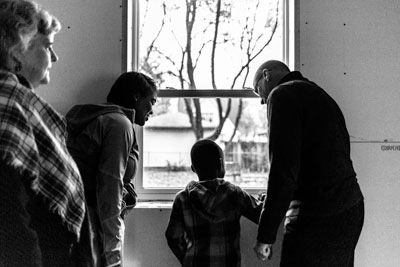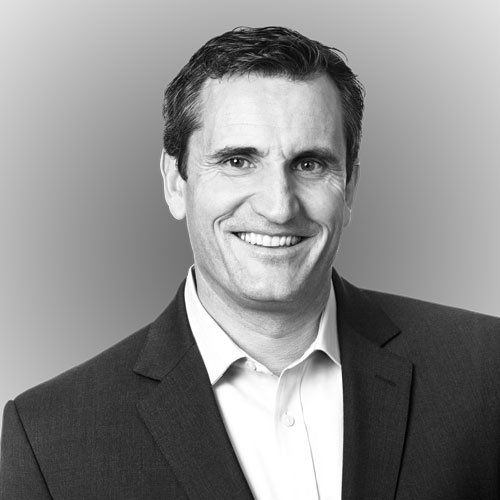Anixter International found itself in a better-than-expected place shortly after its chief financial officer announced his retirement plans in 2009. Not only was the worldwide communications and electrical products distributor able to secure Ted Dosch—a veteran of more than twenty years at Whirlpool—as Anixter’s next CFO, it also created the most seamless of transitions by having Dosch work with the outgoing CFO during the remaining eighteen months of his career at Anixter.
Yet Dosch brought even more to Anixter than his finance-leadership experience at Whirlpool (including the co-lead role when Whirlpool acquired the $5 billion Maytag Corporation in 2006). He also contributed his connections with Habitat for Humanity, the nonprofit home-building organization that Whirlpool has partnered with since 1999. Consequently, Anixter now partners with Habitat for Humanity as well—so much so that Dosch reports there are always more volunteers than available slots when a Habitat project comes Anixter’s way.
This likely comes as no surprise to Dosch, given how much he sees of one company in the other. “Anixter has many traits similar to Whirlpool in terms of culture, values, and integrity,” he says. “The more I learned about the company, the more I knew it would be a great fit for me.”

Since officially assuming the CFO position in 2011, Dosch has put a great deal of focus on better aligning Anixter on a global basis around corporate functions, shared services, and financial planning and analysis. By building more consistent processes within each of those functions, he’s witnessing more efficiency in cost, consistency in quality, and better internal controls.
In short, each part is able to focus more on what it does best and help Anixter’s business leadership make better decisions. It’s an ongoing process—largely complete in North America and Europe, Dosch says, but still in progress in Asia Pacific and Latin America. Considering Anixter has purchased two businesses and undergone a major divestiture in the past year, Dosch is quite pleased with the alignment process thus far. “Not only have these strategic initiatives required a tremendous amount of work by many of the same people who were driving our process initiatives, but also it’s created an opportunity to drive some of the same disciplines into our newly acquired businesses,” he says.
Opportunities of a different kind abound for Anixter’s staff by way of the Anixter Cares program. Established by CEO Robert Eck with support from Dosch and Rod Smith, executive vice president of human resources, the program provides employees one paid day off a year to devote time to the charitable organization of their choice. With the creation of this program came the aforementioned Habitat for Humanity partnership—and a quick show of hands willing to volunteer. “I think Habitat for Humanity has quickly turned into a tremendous partnership for Anixter because our teams of people can get out there in very tangible and real ways and volunteer their time,” Dosch says.
Dosch has worked on Habitat homes on five different continents since 1998 and has served on various boards for the organization over the past decade. While moderate building experience helped get him started—“I was no stranger to a hammer growing up,” he admits—it’s the involvement with Habitat homeowners, who are required to meet a sweat equity requirement for building their own home, that cemented his commitment to the cause. “To build side by side with them. . . to see how hard they work to have a better life for their children . . . it’s had a tremendous impact on me, my wife, and our family,” he says. “That’s why Habitat for Humanity has become such a passion of mine.”
Realizations of what that “better life” means from country to country have stayed with Dosch through the years. He remembers the deplorable living conditions in a part of Cairo, Egypt, where most locals earned their meager living by collecting and sorting trash and lived in a big open area among the trash as well. In that case, Habitat built concrete-block structures to give families a place to live, sleep, and raise children at a slight distance from the squalor below.
In Macedonia, Dosch and other Habitat volunteers helped its Roma population construct cinder-block, one-room houses with concrete floors and corrugated tin roofs. Dosch recalls conversing with a homeowner who’d been living in cramped quarters built with scrap lumber and a dirt floor. “I asked if she was excited to be moving into her new home and tearing down the old place. She seemed confused by the question,” Dosch says. “Then the translator explained that they wouldn’t be tearing the ‘old place’ down because there was a relative waiting to move in. As poor as the ‘old place’ was, it was actually better than where another family member currently lived.”
Habitat building projects continue abroad and in both rural and urban areas across the United States. In 2014, numerous corporate sponsors—Anixter included—gathered at Michigan Avenue’s Pioneer Plaza in downtown Chicago and took action to solve the metro area’s substandard housing crisis by building a house and enough wall sections for twelve other houses. “It created a great opportunity for Anixter and these other generous companies to give their employees the opportunity to give back and help improve the communities in which we live,” Dosch says.
Considering Anixter employees have been known to volunteer and contribute to half a dozen different Habitat projects at a time throughout the Chicago area, the need is obvious. “There are about 400,000 people living in substandard housing across the Chicagoland area,” Dosch points out. “So you don’t have to go all the way to Macedonia or Egypt. We have tremendous opportunities to help families right here at home.”

